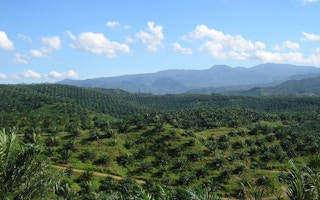Most forest trees that persist in areas dominated by oil palm plantations die before they can mature, a new study shows, emphasising the urgency of conserving or restoring forested areas to ensure the promotion of biodiversity and other ecosystem services.
The study, published in journal Global Ecology and Conservation, looked at the density and distribution patterns of trees across a 1,120-hectare (2,768-acre) swath in the lowlands of Indonesia’s Sumatra Island.
Oil palm plantations blanket this landscape. But using a drone to map the area, researchers identified a scattering of rainforest trees amid this monoculture, at about six to eight trees per 100 oil palms.
But they’re distributed unevenly. In older plantations, located in the southeastern part of the study location, the researchers found the interiors of the plantations there to “barely contain scattered trees,” at 4.6 trees per hectare.
In the northwestern part of the study area, where oil palm cultivation is newer, there were three times as many forest trees remaining, about 14 trees per hectare.
“This might indicate that tree density declines over time in conventional oil palm monocultures,” the researchers said in the study.
There are a number of possible reasons for why there are fewer forest trees inside older plantations. These include consistent removal of forest remnants, suppression of natural tree regeneration, and absence of new tree plantings.
Trees also tend to grow more slowly near faster-growing oil palms, which outcompete them for sunlight, water and nutrients.
But a lack of data on plantation management in the study area means the exact reasons for such a decline remain unknown, according to the study, which the researchers say warrants further studies.
The researchers also found that the forest trees that existed in this landscape were mostly small in stature. Nearly half had a crown diameter, the rough circle formed by its foliage, of less than 4 meters (13 feet); a trunk diameter at breast height (DBH), measured at 4.5 ft (1.4 m) from the ground, of less than 10 centimeters (4 inches); and a total height of less than 7 m (23 ft).
There were only 5.7 trees per hectare with a DBH greater than 10 cm in the entire study area, compared to nearly 600 per hectare in nearby old-growth forest, according to a 2017 study.
“The small crown diameter in the entire study area, nevertheless, suggests, that most trees here were young and disappeared before they reached larger dimensions,” the researchers wrote.
The disappearance of these forest trees in oil palm landscapes means the loss of multiple ecosystem services, such as promotion of biodiversity, that they provide. Even young trees have been shown to promote communities of birds and invertebrates in oil palm monocultures.
Preserving scattered forest trees in an oil palm landscape is even more crucial because they can support secondary forests, the researchers said. As primary, old-growth forests disappear, secondary forests are increasingly considered of high value for conserving biodiversity. But they usually don’t last long enough to recover biodiversity.
In southern Costa Rica, for example, a 2018 study showed that the vast majority of secondary forests lasted less than 54 years, far short of the time needed to recover old-growth levels of biomass or biodiversity.
Scattered trees play a significant role in providing shelter for the growth of secondary forests in landscapes where secondary forests have vanished soon after reestablishment, the researchers said in the new study.
“In particular, they can improve the landscape matrix to support tree- and forest-depending species in the anthropogenically impacted areas,” they wrote.
That makes it important to conserve existing trees in oil palm landscapes and promote their growth, they added. They pointed out that simple policy instruments, like providing information and high-quality seedlings of native species, could encourage landowners to plant trees in their oil palm plantations.
And supporting the growth of scattered forest trees doesn’t have to sacrifice the productivity of oil palm plantations, the researchers said. They cited a study looking at 56 “agroforestry islands” not far from their study area. Spanning 2.3 hectares (5.7 acres), these agroforestry islands were established in 2013 by planting up to six native tree species among oil palms.
In the first years of the agroforestry experiment, the addition of the forest trees didn’t reduce the oil palm yield at all.
They also pointed to another study indicating that the negative impact of additionally planted trees on the oil palm yield is negligible in extensively managed plantations.
“To ensure the survival of trees and further provision of related ecosystem services,” the researchers concluded, “scattered trees in the oil palm landscape need to be conserved and/or restored.”
This story was published with permission from Mongabay.com.

















